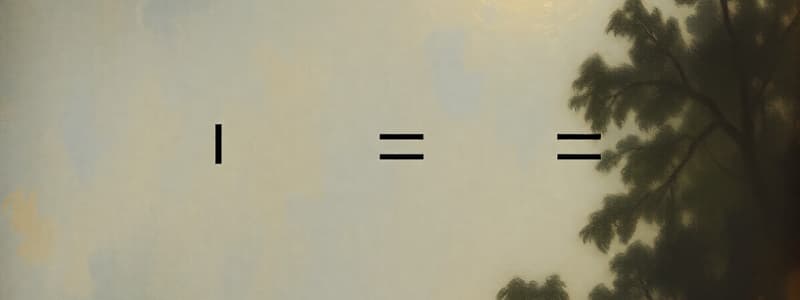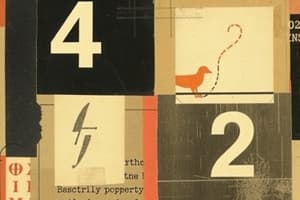Podcast
Questions and Answers
A baker makes 3 cakes. Each cake requires 4 eggs. If the baker already has 5 eggs, how many more eggs does the baker need?
A baker makes 3 cakes. Each cake requires 4 eggs. If the baker already has 5 eggs, how many more eggs does the baker need?
- 19 eggs
- 7 eggs (correct)
- 17 eggs
- 12 eggs
Sarah has a garden with 24 flowers. One-third of the flowers are roses. How many non-rose flowers does Sarah have?
Sarah has a garden with 24 flowers. One-third of the flowers are roses. How many non-rose flowers does Sarah have?
- 16 flowers (correct)
- 18 flowers
- 6 flowers
- 8 flowers
A rectangle has a length of 8 cm and a width of 5 cm. What is the perimeter of the rectangle?
A rectangle has a length of 8 cm and a width of 5 cm. What is the perimeter of the rectangle?
- 26 cm (correct)
- 85 cm
- 13 cm
- 40 cm
Which of the following statements about fractions is correct?
Which of the following statements about fractions is correct?
A movie starts at 2:15 PM and ends at 4:00 PM. How long is the movie?
A movie starts at 2:15 PM and ends at 4:00 PM. How long is the movie?
A class collected data on favorite fruits. Apples received 12 votes, bananas received 9 votes, and oranges received 6 votes. Which fruit is the most popular?
A class collected data on favorite fruits. Apples received 12 votes, bananas received 9 votes, and oranges received 6 votes. Which fruit is the most popular?
What is the missing number in the following pattern: 3, 6, 9, __, 15?
What is the missing number in the following pattern: 3, 6, 9, __, 15?
Which of the following units would be most appropriate for measuring the weight of a book?
Which of the following units would be most appropriate for measuring the weight of a book?
Which of the equations demonstrates the commutative property of multiplication?
Which of the equations demonstrates the commutative property of multiplication?
A farmer has 3 chickens, 2 cows, and 4 pigs. How many total legs do these animals have?
A farmer has 3 chickens, 2 cows, and 4 pigs. How many total legs do these animals have?
Flashcards
What is addition?
What is addition?
Combining numbers to find the total.
What is subtraction?
What is subtraction?
Finding the difference between two numbers.
What is multiplication?
What is multiplication?
Repeated addition (e.g., 3 x 4 = 4 + 4 + 4).
What is division?
What is division?
Signup and view all the flashcards
What are fractions?
What are fractions?
Signup and view all the flashcards
What is measurement?
What is measurement?
Signup and view all the flashcards
What are geometric shapes?
What are geometric shapes?
Signup and view all the flashcards
What is data representation?
What is data representation?
Signup and view all the flashcards
What is problem-solving?
What is problem-solving?
Signup and view all the flashcards
What is mathematical reasoning?
What is mathematical reasoning?
Signup and view all the flashcards
Study Notes
- Mathematics for 3rd grade focuses on building a strong foundation in basic arithmetic, problem-solving, and understanding fundamental mathematical concepts
- Topics covered typically include addition, subtraction, multiplication, division, fractions, measurement, geometry, and data representation
- The curriculum emphasizes hands-on activities and real-world applications to make learning engaging and meaningful for young learners
Addition and Subtraction
- Addition involves combining two or more numbers to find their total, known as the sum
- Subtraction involves finding the difference between two numbers
- Students learn addition and subtraction with numbers up to 1000
- They practice regrouping (carrying and borrowing) when necessary
- Mental math strategies for addition and subtraction are introduced to improve calculation speed and accuracy
- Word problems are used to apply addition and subtraction skills in practical contexts, enhancing problem-solving abilities
Multiplication and Division
- Multiplication is introduced as repeated addition
- Students learn multiplication facts for numbers 1 through 10
- Multiplication tables are memorized to aid quick recall and mental computation
- Division is introduced as the process of sharing or grouping equally
- Students learn to divide numbers using manipulatives and visual aids
- Simple division problems with remainders may be introduced to prepare students for more complex division in later grades
- Word problems involving multiplication and division are used to develop problem-solving skills
Fractions
- Fractions are introduced as parts of a whole or parts of a group
- Students learn to identify and represent fractions using visual models such as circles, squares, and number lines
- Common fractions like 1/2, 1/3, 1/4, 2/3, and 3/4 are emphasized
- Students learn to compare fractions with the same denominator
- Equivalent fractions may be introduced to lay the groundwork for more advanced fraction concepts
Measurement
- Students learn to measure length, weight, volume, and time using standard units
- Length is measured in inches, feet, and yards (or centimeters and meters)
- Weight is measured in ounces and pounds (or grams and kilograms)
- Volume is measured in cups, pints, quarts, and gallons (or milliliters and liters)
- Time is measured in seconds, minutes, hours, days, weeks, months, and years
- Students learn to read clocks and tell time to the nearest minute
- They also learn to use calendars and understand the concept of elapsed time
- Word problems involving measurement are used to apply measurement skills in real-world situations
Geometry
- Basic geometric shapes such as squares, rectangles, triangles, circles, and cubes are introduced
- Students learn to identify and classify shapes based on their attributes, such as the number of sides and angles
- They learn about two-dimensional (2D) and three-dimensional (3D) shapes including the difference between them
- Symmetry and tessellations may be introduced to explore geometric patterns
- Students learn to measure the perimeter of simple shapes by adding the lengths of their sides
- Area may be introduced informally through counting squares on a grid
Data Representation
- Students learn to collect, organize, and represent data using various methods
- Tally marks, tables, and charts (bar graphs, pictographs) are used to organize and display data
- Students learn to interpret data from these representations and answer questions based on the information presented
- Simple surveys may be conducted to collect data from classmates, fostering basic statistical skills
Problem Solving
- Problem-solving is integrated throughout the curriculum to develop critical thinking and reasoning skills
- Students learn to identify the key information in a word problem and determine the appropriate operation(s) to use
- They are encouraged to use manipulatives, diagrams, and other strategies to solve problems
- Multi-step word problems may be introduced to challenge students and promote deeper understanding
- Estimation and checking answers are emphasized to ensure accuracy and reasonableness
Mathematical Practices
- Several mathematical practices are emphasized to promote deeper understanding and proficiency
- Making sense of problems and persevering in solving them
- Reasoning abstractly and quantitatively
- Constructing viable arguments and critiquing the reasoning of others
- Modeling with mathematics
- Using appropriate tools strategically
- Attending to precision
- Looking for and making use of structure
- Looking for and expressing regularity in repeated reasoning
Studying That Suits You
Use AI to generate personalized quizzes and flashcards to suit your learning preferences.
Description
Enhance 3rd graders' math skills with addition and subtraction. Learn with numbers up to 1000. Practice regrouping and mental math strategies in practical word problems, building a strong foundation in basic arithmetic.




